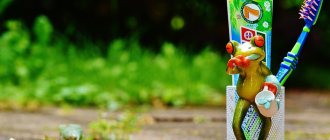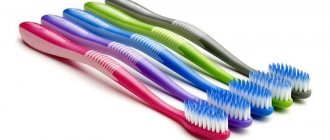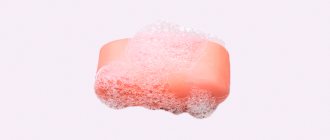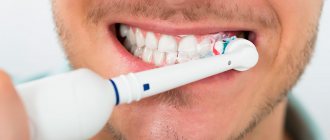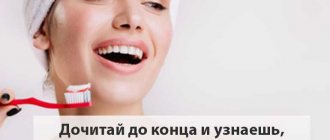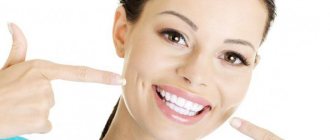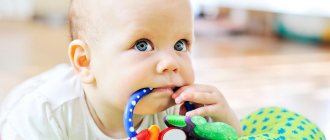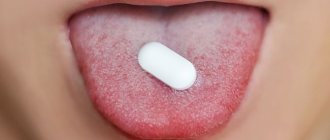A newborn's teeth erupt at 4-7 months. From this moment you need to start cleaning them. First, the parents do this; from the age of 2 he gets used to cleaning himself, and at the age of 3 he should be able to do this without the help of adults. We'll tell you what toothbrushes there are for babies up to one year old and older.
In this article
- The first toothbrush for a child - how to choose
- Criterias of choice
- How often to change a baby brush
A child will begin brushing their teeth independently at about 3 years of age. At this age, he can even use an electric baby brush. But his teeth erupt earlier: for some - at 4, for others - at 6-7 months. Dentists recommend starting to care for your teeth from the moment your first milk teeth appear. A regular brush will not work for a child under one year old; it is better to use a special silicone fingertip. They can not only clean your teeth, but also give a light massage to your gums and relieve pain. The procedure is carried out without pastes and balms.
To ease the condition of a newborn during teething, it is recommended:
- regularly remove saliva with an absorbent towel;
- give the baby objects that can be bitten and chewed;
- massage his gums with a silicone fingertip;
- Wipe the newborn's mouth after eating.
These simple rules will help a child up to one year better cope with the painful period of tooth growth and prevent the development of infections.
At what age can you start brushing your teeth?
Parents need to start taking care of their child’s oral hygiene even before the first teeth appear. Even completely bare mucous membranes are a favorable environment for the growth of bacteria. Before the age of six months, it is, of course, too early to use a brush. But in this case, you can resort to clean gauze soaked in boiled water at room temperature and wrapped around your finger. This is a suitable option to carefully treat the mucous membrane and remove plaque.
Clean gauze should be used before teething
With the appearance of the first primary incisors at 6-7 months of age, you should continue to clean soft and hard tissues using gauze. But you can now switch to a special silicone fingertip - it is also designed for gentle treatment of gums, tongue and the first strong teeth. You need to perform the procedure twice a day - just like with standard cleaning in adulthood.
The next stage usually begins at the age of 1 year. At this time, you can already move on to the first brush, but cleaning should be carried out under close parental supervision. Starting from 3 years of age, the child should be able to carry out the procedure independently.
How to teach a child to brush their teeth
There are situations when the baby categorically does not want to brush his teeth. There is no need to despair, much less force a child. In this case, you can do the following:
- First, tell your child about the benefits of brushing teeth. Explain what consequences can develop if hygiene is not maintained. However, try not to overdo it so as not to intimidate the baby;
- Show by example how to brush your teeth. If there is an older child, have him demonstrate his ability to use a brush. Little children love to imitate adults, take advantage of this opportunity;
- While brushing, come up with a captivating story about your teeth. The plot of this tale will be told to you by the pictures depicted on the brush. You can also carry out hygiene activities in a playful way;
- Pictures and videos of children cleaning their mouths will also be excellent helpers. Complete the pictures with your own stories and be sure to praise your baby;
- and one more trick - delicious toothpaste. Buy one whose taste the child is likely to like, and it will be easier to persuade him. Don't worry if your baby swallows it - properly selected toothpaste is absolutely harmless.
Below we will provide a list of the best toothbrushes for children, taking into account reviews from parents and recommendations from dentists.
Features of oral care during teething
The timing of the eruption of the first milk teeth is individual for each baby. Usually this process begins between 4 and 7 months, and for some, only in the first year of life. This is a delicate period that requires increased attention to the condition of the oral cavity. Experts in pediatric dentistry provide several specific recommendations in this regard:
- Excess salivary fluid must be systematically removed to prevent irritation around the mouth. To do this, you can use a clean napkin or the edge of a towel,
- It is recommended to give the baby special teethers, you can buy these at the pharmacy,
- You should not use teethers with liquid inside - there is always a risk that they will burst. You should also not refrigerate them in the freezer, as this can cause injury to your gums. It is enough for the teether to lie in the refrigerator for only 15 minutes,
- a light massage of the gums with a clean finger has worked well,
- Every time after feeding, the gums should be wiped with gauze soaked in boiled water at room temperature. Some experts allow the use of special anti-inflammatory solutions, but it is better to consult with your pediatric dentist in person on this matter.
Teethers will help ease the baby's teething process.
“My son is 1.5 years old, but the pediatrician is categorically against any brushes until he is two years old. He says there is nothing to clean there, just use a fingertip. In addition, this procedure will be too traumatic for him, and the enamel can be accidentally damaged. So I just clean my tongue with a bandage soaked in water, and my teeth separately with a fingertip.”
Ekaterina F., from correspondence on the woman.ru forum
During the period of formation of the primary occlusion, the child’s body weakens, and a slight, but still, decrease in local immunity occurs. This means that it is at this time that the baby is at greater risk of contracting an infection. The gums are already inflamed, so you should not carry out additional manipulations too often and intensively. Care should be as gentle as possible, but attentive and regular.
What is this?
For brushing children's teeth, a silicone toothbrush for babies, which fits comfortably on your finger, is suitable. With its help, simultaneously with the hygiene procedure, the gums are massaged, which is especially important during periods of teething. Fingertips for cleaning children's teeth are convenient and simple; they can be used until the child learns to brush his teeth himself. Thanks to this simple thing, you can not only gently remove plaque from the baby’s first teeth, but also massage his gums, which is done due to the presence of villi and pimples.
Everyone understands that a child at this age will not yet be able to brush his teeth correctly, and parents will have to finish the “work” for him. Still, you shouldn’t delay getting used to doing the procedure yourself. The sooner you instill in your baby the healthy habit of brushing his teeth, the less hassle there will be later.
It's not just about cleaning, but also about teaching the baby a very important hygiene procedure. Therefore, it is very important that training is timely. In addition, it is much easier to accustom a small child to a toothbrush at a time when he “tastes” everything and puts it in his mouth.
Important! From 1 year you can use other toothbrushes.
The first full-fledged brush must meet the following requirements:
- have soft and well-polished rounded bristles in an amount of about 20 tufts - this will avoid damage to the gums;
- differ in the small size of the head - it is enough for it to be comparable to two baby teeth;
- have a handle that is comfortable for a child to hold independently, preferably non-slip.
Manufacturers of toothbrushes for children pay special attention to their design. Children are delighted with toy brushes made in the shape of a character from their favorite cartoon or fairy tale.
Attractive designs often decorate the handles of children's brushes. Undoubtedly, the aesthetic side is also important, because it helps to instill interest in the process of brushing your teeth, but still, first of all, when choosing a brush, you need to focus on its technical characteristics.
Since silicone brushes wear out quickly, you can purchase a set of brushes at once.
First toothbrush – before and after one year
As mentioned above, each stage of growing up requires its own oral care. The following are the basic principles of maintaining hygiene in childhood:
- up to 1 year - clean the gums with gauze soaked in boiled water at room temperature, and also use silicone fingertips for more thorough cleaning of the first teeth that appear,
- after 1 year - continue to use finger pads and gradually switch to a baby brush with rubber bristles and a limiter on the handle that prevents tissue injury,
- with the appearance of incisors, canines and molars, you can begin to use a full-fledged model, but taking into account children's age, therefore with a small head and soft bristles.
You can rely on the age markings on the packaging, but most often they are too vague. Therefore, it is better to choose a model individually, according to the recommendations of the observing pediatric dentist.
Tips for choosing
Nowadays, you can easily find toothbrushes for every taste and color in stores. When choosing, many mothers rely only on brand recognition and price category. Often parents, wanting their child to get the best, buy expensive brushes, because a high price seems to be a guarantee of quality. However, the correct choice lies in other characteristics. So what should you look for when looking for a toothbrush?
- Appearance. This is a very important criterion for a baby. A bright object will arouse the child's interest and encourage him to try to brush his teeth. Often, many parents are faced with a problem when they cannot persuade their child to brush his teeth. A bright brush with cartoon characters will be an excellent helper in this case.
- Age criterion - you need to focus on the child’s age not only when looking for toothpaste, but also when choosing a brush. Depending on this indicator, brushes of different sizes, with different bristles and designs are produced. For children under one year old, a device with a chewing rod will be suitable, which will relieve the itching from teething. Children of preschool and primary school age need a brush with bristles of different lengths to ensure complete oral care.
- Handle – we advise you to pay attention to this parameter, since an uncomfortable brush handle can interfere with quality teeth cleaning. The handle should be covered with rubber anti-slip material, and its length varies depending on the age of the child.
- Brush head. It should not be too large, otherwise it will cause discomfort for the child. The shape should be oval without corners; it may have a rodent for young children.
- Bristles - the most optimal length of the bristles should be 10-11 cm. This size will ensure the best quality cleaning of teeth and interdental spaces. The hardness should be soft or medium. You should not buy brushes that are too hard, as they can injure your baby’s delicate gums. In addition, it is recommended to additionally purchase a small cover for the bristles, which will protect against pathogenic bacteria that can settle on the brush.
- In recent years, parents have been leaning towards using electric toothbrushes. It is best to start using such devices after 3 years. An electric brush must be intended for a child. The speed of vibration and rotation, the length of the tip - all these parameters strictly depend on the age category.
- Special mention should be made of the small silicone finger brushes. They are used in babies 3 months of age and above. Such devices will help cleanse the oral cavity of microorganisms and relieve itching and pain from teething.
Finger tip for cleaning gums and first teeth
It was already mentioned above that the first “brush” for a child should be a fingertip. Essentially, it is a small silicone cap that is designed to be placed on mom's finger. Cleaning with it is carried out according to the same principle as with a piece of gauze. This is a special device that does not injure children’s delicate gums, but provides a beneficial massage and improves blood circulation in soft tissues. Recommended age for use is 6-10 months.
With the appearance of the first teeth, you can use special silicone finger guards
It is important to consider that such a fingertip needs to be updated every 1-2 months. At the slightest sign of damage to the integrity of the brush, it must be urgently replaced with a new one. The cleaning procedure itself should take about 4-5 minutes.
Advantages and disadvantages
How to brush your child's teeth at one year of age
This product has the following advantages:
- hygienic care of the item is quite easy;
- it contains absolutely no harmful substances;
- provides a massage effect;
- Since it is made of soft material, it is almost impossible to injure the child’s gums.
In addition to its advantages, the brush also has disadvantages:
- short service life. Very often, when little children start teething, they start to itch, so the baby can simply chew on the device;
- The size of the silicone brush is more designed for women’s fingers, but it may not fit on men’s;
- It often happens that a child bites the brush, naturally, with his finger inside it, so parents need to be careful.
How to choose a brush for a child - main characteristics
A product for the first teeth should not only be bright and attractive. It must meet a number of important criteria, and here are the main ones:
- the product must be made of high-quality plastic - be sure to check for a certificate,
- For the first years, soft or ultra-soft bristles are suitable. You can switch to medium hardness from the age of three,
- give preference to synthetic bristles, as they are more wear-resistant and do not create a favorable environment for the growth of bacteria. Natural bristles are a real breeding ground for harmful microorganisms, and regular disinfection quickly renders the product unusable. The best option during the “teeth to teeth” period is silicone bristles,
- for babies older than one year, the length of the pile should be about 11 mm, let’s say a multi-level option with a V-shaped arrangement of synthetic bristles,
- The handle must have rubberized anti-slip elements. From the age of 2-5 years, the length of the handle can reach 15 cm. It is desirable that there is a flexible connection between the base and the head,
- the head size should not exceed 15 mm - for the smallest. From the age of 2, its length can reach 20 mm, and its shape must be smooth and streamlined1,
- It is desirable that there is a rubberized ribbed surface on the back of the working area - it is designed to clean the tongue.
Be careful when choosing a children's toothbrush.
As for the appearance and design, everything depends on the preferences of the parents and the baby. The modern assortment offers the widest variety for every taste and color.
Average price category
CpCS Medica CS-561 Kids
These are quite original products that can greatly make life easier for parents whose child categorically refuses to brush their teeth. First of all, the brush is equipped with an electric motor and also has an LED backlight for the nozzle, so brushing your baby’s teeth will be much more interesting and fun. The device has an original timer, which once every half a minute will remind the child to move on to another stage of cleaning.
After the time allotted for brushing your teeth is over, the device will turn off automatically. This brush runs on one AA battery, has a very beautiful and bright color, and is capable of creating up to 16 thousand vibrations per minute. The handle is made of rubberized materials, so the child will feel comfortable holding it in his palms. The brush is suitable for babies aged 1 to 5 years.
Advantages:
- There is a timer and automatic shutdown function;
- The optimum ratio of price and quality;
- Low weight of the device;
- An effective and safe model;
- The kit includes a spare nozzle;
- There is LED backlighting.
Flaws:
- It works quite loudly - a child who is not used to it may get scared.
Toothbrush CpCS Medica CS-561 Kids
Curaprox CS smart
This toothbrush was developed by Swiss dentists in such a way that it was as close as possible to the adult version of the brush from the same manufacturer. The product is suitable for children aged 5 years and older. With its help, you can quickly and effectively clean your gums and maintain the natural whiteness of your teeth.
The head has a rectangular shape, which is not very typical for most children's toothbrushes. There are 7600 bristles on it, the diameter of which is 0.08 mm. They are very soft, so they are able to penetrate into the interdental space. With their help, it is possible to thoroughly clean the chewing teeth, remove even serious plaque without damaging the enamel. The handle is entirely made of high-quality plastic and has the shape of a rectangle.
Advantages:
- Quite a large tuft of bristles, but at the same time it is very soft;
- Cleans plaque effectively and carefully;
- Comfortable to hold;
- Attractive appearance;
- Suitable for absolutely all types of teeth.
Flaws:
- You need to work with the rectangular head as carefully as possible, otherwise there is a risk of causing pain.
Curaprox CS smart toothbrush
Pigeon 10541
This educational set includes three toothbrushes and is suitable for children aged 6 to 18 months. With its help, it will be possible to teach the child to independently care for the oral cavity in the future. Each of the brushes in this set has its own overall dimensions and purpose. The first brush is used during teething. This is a very mobile model, it is painted in white and pink tones, characterized by an elongated massive head and fairly thick bristles of various lengths.
More: TOP 10 auto tracks for children: how to choose a good children's auto track
The second brush is used for up to a year and is characterized by medium overall dimensions. It has a white-yellow color, a small, oval-shaped head. The third model is intended for children under 1.5 years of age. It is the longest of those presented and has a long pile. All brushes are equipped with soft bristles, the handle is rubberized and equipped with a limiter.
Advantages:
- All brushes are very soft;
- High quality bristles;
- Safe to use for both the child and his parents;
- Attractive, but very calm product design.
Flaws:
- Not detected.
Toothbrush Pigeon 10541
Review of the best brands - for children under 3 years of age and older
Below is a rating of the best manufacturers of children's toothbrushes, based on expert recommendations and reviews from parents on the Internet. The table contains all the key information about brands that produce products for children under 3 years of age and older.
| Brand and country of origin | Characteristics and cost | Advantages and disadvantages |
| Canpol (Poland) | There are several models in stock. The Canpol babies silicone fingertip, which is ideal as a first tool for maintaining hygiene, costs about 140 rubles. There is also an option with a restrictor in the form of a ring, designed for ages from six months, costs about 200 rubles. | The fingertip has soft bristles that provide additional massage to the gums. The silicone model is characterized by increased softness of the bristles. Therefore, according to reviews, it does not always clean plaque and dirt thoroughly enough. |
| Happy Baby (UK) | Happy Baby Tooth care x3 kit with limiters, cost about 175 rubles. | Soft bristles and a protective ring, available in several models: in the form of a teether, a mucous massager and a full-fledged brush. |
| Pigeon (Japan) | Educational model for children from 10 months – 200 rubles. The range also includes a set for children from 18 months, the cost of which is about 400 rubles. | The training version, compact and convenient, designed just for a child’s hand, is equipped with a limiter. The set includes a double-sided model (from 6 to 8 months), a single-sided model (from 1 year), and a brush with a ring (from 1 to 3 years). |
| Mam (Switzerland) | The cost of a brush for mother and baby is 274 rubles. | The model is designed for ages from 6 months. Due to the special ergonomic design of the handle, the brush can be comfortably held by mother and child. Material: polypropene and silicone. |
| Oral-B (USA) | Battery operated model for ages 3 years and up. Cost – about 730 rubles. | Original design with a rubberized body, high cleaning efficiency due to circular rotation of the head, and a timer. Replacement heads are available for sale. |
| SILCA Putzi Baby (Germany) | For children over 1 year old, cost – 130 rubles. | Ergonomic rubberized handle, interesting design and soft bristles with good cleaning performance. |
List of the best children's brushes in the budget segment
Oral-B Baby
This model is intended for ages 0-2 years. The head is oblong with very soft bristles. The design is classic. The main purpose of the product is for teething teeth and gums. The holder is curved, on the reverse side it has a rubberized insert with concave grooves for fingers - it does not allow it to slip in the hand.
Oral-B Baby toothbrush
Advantages:
- design;
- soft bristles;
- comfortable;
- inexpensive;
- safe;
- “copes with his responsibilities”;
- good quality.
Flaws:
- not identified.
The average cost is 150 Russian rubles.
Pigeon 10542
The Pigeon kit is a step-by-step system for teaching yourself how to brush your teeth. It consists of two small objects of different colors (white-green, white-yellow), one of which is for babies from 0 to 12 months with rubber bristles for teething teeth and gums + preparation for the transition to a standard brush, the other is for 1-3 -year-olds (mastering the skills of self-cleaning the oral cavity).
The head of the second product, reminiscent of an adult model, has short, very thin bristles of a soft degree of rigidity.
The handle is ergonomically shaped, with a silicone insert that has a limiter at the top so that the child cannot insert it deeply.
Pigeon 10542
Advantages:
- fits comfortably in the hand;
- small size;
- ergonomic shape;
- high degree of security;
- equipment;
- high quality
Flaws:
- not identified.
The average cost is 290 Russian rubles.
PresiDENT Kids-Junior
This dental device with an age limit of 5-11 years and a bright design is intended for self-cleaning. The handle is thickened, with rubber inserts. On the front side there is a slope for the thumb, on the reverse side - for the rest. The head is cone-shaped with soft graduated nylon bristles with rounded tips, divided into two tufts: the upper one is small, blue, the lower one is larger, white, in combination they allow you to thoroughly remove food debris in the interdental spaces and effectively clean the back teeth.
Technical characteristics: 14.5 cm – length, 25 grams – packaged weight. The set includes a protective cap.
PresiDENT Kids-Junior toothbrush
Advantages:
- non-slip handle;
- providing careful care;
- appearance;
- effective;
- inexpensive;
- storage cap.
Flaws:
- not identified.
The average cost is 190 Russian rubles.
Curaprox Curakids CK 4260
This compact, cute brush is suitable for use by children aged 0 to 4 years. That is, this brush will be an excellent tool for caring for your very first tooth. Delicate and very soft bristles will not allow you to injure the child’s gums, and the comfortable rubberized handle will be easy to hold in your hands.
The special structure of the bristles is aimed at high-quality and gentle removal of plaque; all materials from which the brush is made are completely safe.
Curaprox Curakids CK 4260 brush
Advantages:
- stand at the base of the brush;
- Ease of use;
- gentle cleansing.
Flaws:
- high price;
- minimalistic design.
The average cost is 460 Russian rubles.
BABYONO
The set of toothbrushes includes three accessories, each of which corresponds to a specific age of the baby. Such a set will be a successful and convenient purchase, since parents will not have to constantly search for and purchase brushes for a new stage of oral care. What brushes are included?
- Massager for teething period. This teether will provide complete care for your baby’s gums.
- Silicone brush for first teeth. It is made of safe materials, the bristles themselves are very soft.
- Silicone toothbrush for the care and cleansing of teeth and oral cavity in older children.
The brushes are available in different colors, have a comfortable handle and do not cause local allergic reactions.
BABYONO brush set
Advantages:
- The set contains the entire set of brushes - it’s very convenient;
- comfortable handle;
- safety.
Flaws:
- not found.
The average cost is 270 Russian rubles.
DIES KIDS
The soft brush is designed for oral care for children aged 2 to 8 years. The bristles carefully and carefully remove plaque from the teeth, and a special pad will remove plaque and harmful bacteria from the surface of the tongue.
When brushing teeth, it is extremely important not to damage the child’s fragile tooth enamel, which is why the manufacturer has created a brush with rounded bristles. This approach will ensure safe cleansing.
DIES KIDS brush
Advantages:
- ergonomic handle design;
- careful care;
- suction cup at the base of the brush;
- complete and high-quality oral care.
Flaws:
- none.
The average cost is 35 Russian rubles.
Oral-B Junior.
This accessory is designed specifically for older children. Namely for those guys who already have both molars and baby teeth. The intersecting bristles are made of soft materials. This brush structure allows you to quickly and safely remove food debris without damaging your tooth enamel. The ergonomic non-slip handle will also make the hygiene process more convenient.
The brush is recommended for children from 6 to 12 years old.
]Oral-B Junior brush
Advantages:
- unique bristle arrangement system;
- does not slip in your hands.
Flaws:
- none.
The average cost is 130 Russian rubles.
Bebe comfort
Very interesting and unusual brushes from the French brand. The set includes two all-silicone brushes and a brush with regular bristles. These hygienic devices can be used for both teething and oral hygiene.
A comfortable rubberized handle will prevent slipping, and the material used will allow you to keep the brushes clean. To do this, just boil them in water for a few minutes. Recommended age for use is 3-36 months.
Bebe comfort brushes
Advantages:
- The set includes a case for brushes;
- versatility and safety of use;
- easy to sterilize.
Flaws:
- harsh stubble.
The average cost is 440 Russian rubles.
Colgate SpongeBob
According to manufacturers, this electric brush cleans teeth more effectively and efficiently than a regular one. This is due to the fact that the device has a small vibrating head of a standard nozzle, which carefully cleans the oral cavity. The enamel is not damaged during brushing.
The colorful handle of the accessory has a large power button, so it will be easy for your child to use the device independently. Power is supplied via batteries. The brush is suitable for children from 3 years old.
Colgate SpongeBob brush
Advantages:
- low cost;
- batteries included;
- bright design.
Flaws:
- no timer;
- not the highest quality material;
- one non-replaceable nozzle;
- Suitable for standard cleaning only;
- There is no battery charge sensor.
The average cost is 290 Russian rubles.
Aquafresh My baby teeth
And finally, we present to you children’s favorites – brushes with bright, replaceable caps in the shape of animals. These accessories are designed for children 3-5 years old.
The bright and cheerful design will motivate the baby to brush his teeth regularly, and the comfortable handle will prevent slipping in his hands. There is a suction cup at the base of the brush, making it easy to store the device. The soft bristles will gently clean your teeth and gums.
Aquafresh children's toothbrush
Advantages:
- protective cap;
- suction cup for storage and fastening;
- careful care;
- bright appearance;
- ergonomic design.
Flaws:
- The brush quickly loses its presentation.
The average cost is 90 Russian rubles.
When can you start using electric models?
Experts in pediatric dentistry do not recommend purchasing electric toothbrushes for children under 2 years of age. In general, experts advise starting to use them no earlier than 5 years. In any case, it is impossible to use an electric model on an ongoing basis at an early age. The enamel of baby teeth is quite thin and fragile and can be easily damaged. Starting from 5-6 years old, you can begin to periodically use an electric model - the teeth should gradually get used to its effects.
An electric brush can be used from 5-6 years old
Features of care
It is important not only to choose the right brush, but also to know the features of caring for it. Following the recommendations of dentists will help extend the life of your teeth and improve the quality of hygiene procedures. After each use, the product must be washed with warm water and baby or antibacterial soap. You can also use natural laundry soap for this purpose, but after the procedure it must be rinsed thoroughly. If this is not done, a characteristic odor will remain on the product, and the child will refuse to brush his teeth.
It is best to store the brush in a special case, but you do not need to put it away immediately after use. After washing, it is better to put it in a clean towel or napkin and leave for 30–40 minutes. This is necessary for the product to dry completely. Regular drying with a towel is not enough for this, because moisture accumulates between the tubercles located on the surface of the brush, and it is quite difficult to dry these places.
How to properly care for your first toothbrush
Modern children's models are not designed for intensive heat treatment. This means that they do not need to be doused with boiling water or boiled. They must be washed thoroughly with soap after each cleaning. It should be stored in a separate glass, with the bristles facing up. When purchasing a brush for a child, be sure to carefully read the instructions and care recommendations.
On a note! Many parents are interested in how to treat the product before first use. In fact, after unpacking the brush remains completely sterile and does not require any additional manipulations. Sometimes it is advised to pour boiling water over the bristles, but this will only help soften them a little to avoid injury to the gums.
Always consult your pediatric dentist about any hygiene products, including toothpastes. Only a doctor will be able to accurately assess the current condition of primary incisors and molars and, based on this, give correct recommendations for oral care.
1Borovsky E.V. Dental health is in our hands, 2004.
Expensive toothbrushes for children
Montcarotte Kids Toothbrush soft
This model is designed for ages from 1 year, taking into account all the structural features of the dentition and the individual brushing technique of each baby.
The oval-shaped head with fibers made of high-tech polyamide, each of which is perfectly rounded at the end, has a soft degree of rigidity and does not absorb moisture, which reduces the risk of the appearance of a bacterial environment in them. The bristles are resistant to deformation, so they last several times longer in comparison with analog products in this price category. They do not injure the gums and gently polish the surface of the tooth enamel.
The handle is flat, wave-shaped, made of hypoallergenic plastic and equipped with rubber elements with a recess into the body, which allow you to securely hold the brush in a child’s hand.
Montcarotte Kids Toothbrush soft
Advantages:
- value for money;
- high degree of security;
- gentle and effective care;
- for any degree of gum sensitivity;
- comfortable handle.
Flaws:
- not identified.
The average cost is 1010 Russian rubles.
ROXY-KIDS Firefly
The classic model with a suction cup for ages from 3 years, weighing 35 gamma and measuring 25/6/5 cm, is equipped with an oval oblong head with a tapered end and soft nylon bristles. The handle is transparent, red, ergonomically shaped, equipped with a built-in light timer that flashes for 1 minute - the optimal time to complete the cleaning process.
ROXY-KIDS Firefly
Advantages:
- presence of backlight – timer;
- anti-slip handle;
- convenient storage (has a suction cup);
- gentle cleansing.
Flaws:
- not identified.
The average cost is 1035 Russian rubles.
Xiaomi Soocas C1
A sound model for children aged 4 years and older with a small vibrating elongated head equipped with DuPont bristles with rounded bristles that are gentle on tooth enamel and gums.
The body is made of FDA plastic - an environmentally friendly material, equipped with a 2 W battery with a capacity of 850 mAh, which lasts up to 20 days (80 minutes) of use on a single charge, when using the device no more than 2 times a day for 2-3 minutes. Power can be restored within 12 hours.
Model functionality: 2 operating modes (daily and delicate cleaning), there is a habituation function, a tooth pressure sensor, electronic control of nozzle wear (only one in the set), a timer. The main feature of the device is synchronization with a smartphone via the Bluetooth communication protocol. SoocasKid mobile application for Android 4.4+, iOS 8.0+ phones.
Additional information: there is a storage stand, stickers, 2 replaceable panels. Product weight – 106.5 grams.
Switching modes is carried out using magnetic plates by pressing a button. You can instill hygiene skills in a child in a playful way: a special program displays the process of fighting bacteria on the phone screen in the form of an entertaining cartoon. As the cleaning progresses, the main character of the game (the rabbit) moves towards the finish line; if oral care is performed incorrectly, the automatic mode notifies you about this.
Xiaomi Soocas C1
Advantages:
- appearance;
- holds a charge for a relatively long time;
- comfortable head;
- simple controls;
- appearance;
- can be taken on trips;
- optimal level of bristle stiffness;
- multifunctional.
Flaws:
- expensive attachments, difficult to find;
- recharging time.
The average cost is 2190 Russian rubles.
Oral-B Kids Mickey Mouse
This unit is intended for oral care for children aged 3 years and older. The brush runs on a battery; a charging base is included in the kit. The device has a beautiful appearance that will interest the baby. Another plus will be the melody that accompanies brushing your teeth. The melody lasts 2 minutes, so you don't have to time yourself to clean.
You also don’t have to worry about your child’s safety. The brush body is made of a special material that is resistant to work in conditions of high humidity.
Oral-B Kids Mickey Mouse brush
Advantages:
- built-in timer;
- light weight;
- careful care;
- safety;
- beautiful appearance.
Flaws:
- expensive replacement tips.
The average cost is 1,700 Russian rubles.
Hapica Kids
Once again, an electric toothbrush is in our selection. This Japanese brand has been around for over 30 years. During this time, the manufacturer has proven the quality and safety of its products. The main principle of the brand is maximum useful functions and no useless excesses.
The recommended age for using the accessory is 3-10 years. A small brush head, soft bristles and a frequency of oscillatory movements of 7,000 per minute will provide comfortable care for baby and molar teeth.
Although the brush is not equipped with a bright screen and LEDs, it does come with 6 attachments for any need: an ionic attachment, an attachment for the prevention of gum inflammation, and for braces. In addition, attachments vary depending on the age and desired stiffness of the bristles.
The device operates using a AA battery, which will allow the brush to last for at least 3 months. The accessory itself is very quiet and compact - its weight is only 58 g.
Hapica Kids
Advantages:
- light weight of the device;
- low noise level;
- all manufacturing materials are completely safe;
- variety of shades;
- efficiency and ease of use;
- Beautiful design.
Flaws:
- no built-in timer;
- There is not enough teeth whitening brush;
- There is no gum massager.
Brush selection
The market offers us many different toothbrush shapes and hardnesses. Their markings are completely different. How to choose the right brush according to your age?
There are different types of brushes for the first teeth:
- from six months to 2 years;
- from 2 to 4 years;
- from 4 to 7 years;
- more than 7 years.
If you compare the first two options, you will notice that the toothbrush is quite voluminous compared to the next one. This was specially thought out to make the brush more convenient and less traumatic for a small mouth.
Up to 1 year, the brush can have silicone bristles and the edges of the head are rounded
Therefore, a larger and more rounded brush is suitable for the first teeth. Research has determined that this rounded shape of a toothbrush is the most comfortable and less traumatic. After six months, the stubble is softer than subsequent ones. Although the Soft marking is written in almost all of them.
Some brands of toothbrushes for children have a finger ledge so that the child can comfortably hold the toothbrush. Or the handle is rubberized to prevent small fingers from slipping.
Many companies have a color indication of the bristles themselves, not just for beauty. This is an indicator of the wear resistance of the toothbrush itself. As soon as the bristles become faded, this is an indicator that the toothbrush needs to be replaced.
Important! We start cleaning once a day, preferably in the evening. By the age of 1.5 and 2 years, children should brush their teeth with a toothbrush 2 times a day.
A good toothbrush:
- It has a bristle indicator, which signals us about the need for replacement.
- Supplemented with a power ledge to fix the brush holding stop. Or protrusions that prevent the handles from slipping.
There are toothbrushes of the most unusual configurations that allow you to brush on one side and the other at the same time. But it is not for everyone, because it is more traumatic. Might be perfect for some. For some, it won't suit you at all. Children's toothbrush should change as children age
Toothbrushes like these, which have an extraordinary design, are more individual. This must be taken into account through personal trial and error, unfortunately. A toothbrush with a power ledge on the tip will be ideal for thoroughly cleaning your first teeth.
Typically, silicone inserts are inserted for permanent teeth. Rubbing of the enamel surface occurs. Not just cleansing, but additional polishing of pigments, which are consumed more by adults than children.
Or there are silicone tentacle inserts to massage the gums. This is relevant in adolescence over 14 years of age, when inflammation occurs due to hormonal changes.
It is most effective when the bristles have different directions, but are more suitable for teenagers when all the teeth are permanent. For smaller teeth, straight bristles or a slight power ridge at the tip will suffice.
Finger brush from
This company has been operating since 1990.
It produces products for parents, with the help of which they raise and educate their children.
The company specializes in products without which normal child development is impossible..
Taking care of parents and children, wanting to provide them with comfort and time savings, the manufacturer designs products in such a way that they are as comfortable, reliable, and ergonomic as possible.
Parents also get involved in the process of creating products.
It is worth noting! The company is engaged in the production of safe products that are designed in accordance with current directives and standards of the European Union.
For example, toys undergo rigorous checks and tests before they hit store shelves.
Thanks to strict production control, the company guarantees the high quality of its products .
That is why the company is very popular among parents.
A silicone toothbrush from this manufacturer is sold together with a plastic case.
Thanks to this, the product is convenient to store and carry with you if necessary. Therefore, this is a significant advantage of this brush.
The length itself is 5 cm , it is made of high-quality and soft silicone .
Keep in mind! The fingertip does not have any specific smell or taste, so you can safely brush your child’s teeth with it.
On one side of the product there is a pimpled massage surface, which is a big plus for those children who are teething.

